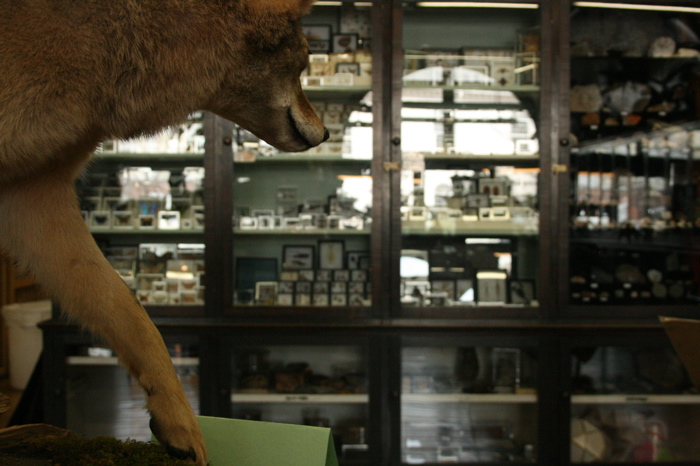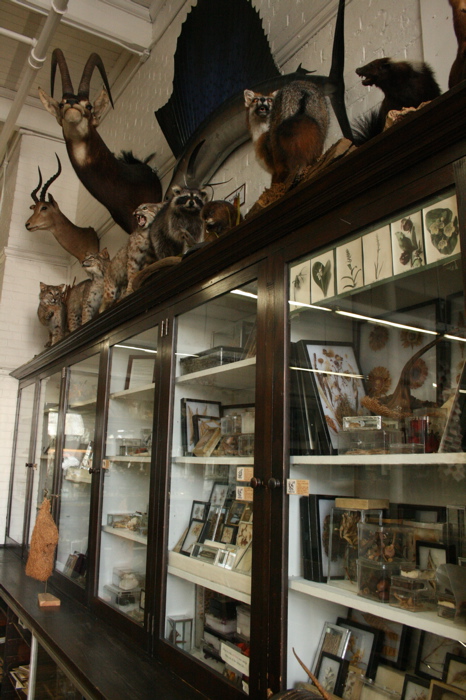What is a Cabinet of Curiosities?

A black bear rears in welcome by the door, while a fawn with marbled eyes looks on from across the room. Looming glass fronted cabinets with slightly warped casings line the walls. Each cabinet contains hundreds of objects, each with its own curious history. This shelf is full of creatures that once hopped, crawled, and buzzed, while that is full of swimmers and gliders. Here are the things that flew, and there are those that bloomed. But now, each of these objects is “stuck,” pinned, glued, stuffed or trussed. Each little pane of glass has been meticulously numbered and labeled, and every box has its appropriate place amid a long list of artifacts. One freestanding cabinet contains jars and jars of fetuses in formaldehyde baths. Wire-strung skeletons lounge through the door, while even more shelves offer boxes and boxes of jaws or femurs or vertebrae. This eclectic collection of things that so strongly resembles a 16th century Wunderkammer is, in fact, RISD’s “Animal Lab.” Art students come here to explore the natural world without ever having to leave the shelter of College Hill.
Few of the objects in the Animal Lab would be a mystery to the contemporary student. The 21st century is an era of impatience. Cell phones, televisions, and Internet make information immediately accessible. We have all been exposed to graphic imagery through photographs and films, and the computer screen seems to be our modern day “cabinet of curiosities.” So why then, in an age seemingly devoid of wonder, is the Animal Lab an almost sacred place? Visitors automatically lower their voices to a whisper, and step carefully across the floor. The atmosphere is akin to that of a library, a museum, or even a place of worship. It is as if the glass and the formaldehyde, the mounting pins and the cotton, serve to sanctify the objects that they preserve and display. Why do we react this way? Perhaps some of this wonder is a vestige of the beginnings of collecting in this manner: the birth of the Cabinet of Curiosities.
Wunderkammern first began to appear in the homes of royalty and the aristocratic in 16th century Europe. They were soon dubbed “wunderkammern,” or, “wonders or miracles of the world,” and were intended to summarize the world to the very corners of the Earth. Another name for such collections was “vernunfft-kammer,” or, “room of reason.” Guides and manuals instructing collectors on proper preservation and display techniques began to appear in the second half of the 16th century. Samuel Van Quiccheberg, a Flemish doctor and curator for the ducal art collection in Munich, published the first known manual in 1565. His book, entitled “Inscriptiones vel tituli theatri amplissimi” defined the ideal wunderkammer as having five main sections. According to Quiccheberg, a complete collection consisted of objects dealing with genealogy, handicrafts dating from the antiquity to the present, natural specimens, technical and cultural objects, and a gallery that included paintings, drawings, and engravings. Finally, Quiccheberg stressed the importance of a collection acting also as a library, workshop and apothecary. Collecting was seen as beneficial in both an intellectual and a social sense; these repositories of knowledge both answered questions and piqued scientific curiosity. Additionally, showing one’s own cabinet was an excellent display of wealth and social prestige. The most impressive collections attracted visitors from all over Europe, which occasionally included royalty.
Wunderkammern may have served as a microcosm of the world to the collectors of the 16th century. However, to the contemporary viewer, these collections reveal more about the clash of 16th century ideologies than they do about the wider world. The cabinet of curiosities is a product of an era of exploration and discovery, in both an intellectual and a physical sense. The invention of the compass in the 13th century by Hispano-Arab cartographers facilitated increased exploration of the unknown. Wunderkammern held the relics of travels to the four corners of the earth, byproducts of an increase in trade and colonization. The exploration and “discovery” of the continents was an intriguing topic for many people as indicated by the popularity of books such as Sir John Mandeville’s Travels, published in the late 1300s. Before the 16th century, collecting had mainly focused on artifacts from Greek and Roman antiquity. However, along with the increase in travel came a shift of power and attention away from the Mediterranean. As the Netherlands and Great Britain rose to power in Europe, this fascination with colonization and the mapping of the world shifted the eyes of the people outwards and away from Europe. Collectors were now interested in the exotic nature of artifacts hailing from the unknown, the corners of the world that were still off the edge of the map.
Additionally, the Church was losing its religious battle for control over the people of Europe. The strict dogmatic laws that had previously prohibited scientific exploration were being pushed to their limits. For example, the Church disavowed and banned the study of human anatomy through dissection, yet increasing numbers of volumes were being published on human anatomy at this time. The exploration of the world through a cabinet of curiosities marked a similarly tangible approach to the natural sciences.
Despite the radical nature of this new scientific approach, the cabinet of curiosities was a contradiction. While wunderkammern marked an encyclopedic and objective approach to nature, the wonder and curiosity that they inspired also preserved a sense of mysticism that mirrored religious beliefs. An excellent example of this contradiction lies in the collector’s treatment of an object such as a piece of coral. How should this curious thing be defined and categorized? Because few people were familiar with coral in its natural environment, they invented definitions based on their personal ideologies. Therefore, the question of how to define coral could be approached from a medical, superstitious, scientific, or purely aesthetic point of view. Some used coral as a treatment for anemia; others kept it as a talisman against being struck down by lightning, or the evil eye; naturalists debated whether to classify it as mineral or animal; and finally, those with an eye for aesthetics simply arranged it based on its brilliant red hue. Clearly, there was no one correct way to execute a cabinet of curiosities; the personal level of choice involved in collecting was representative of the range in scientific and religious values at this time.
Today, Internet and cable feed our wunderkammern. Perhaps the wild chaos of the web is a reflection of an even more intense clash of ideologies among the people of the modern world. But LCD screens cannot provide us with this sneaking feeling of wonder that a physical collection incites. There is something about being able to press your nose to the glass, or to reach out and touch a thing that once lived or served a purpose for someone, somewhere. It may be a remnant from the beginnings of collecting; after all, the roots of the collection are tied into both religion and science, art and history, curiosity and culture. Perhaps the sanctification of artifacts is not a negative thing. For if we feel that these books and artifacts are in some way holy, maybe that will be enough inspiration to continue to preserve them for future generations.

Bibliography:
Blom, Philipp; 2003. To Have and to Hold: an Intimate History of Collectors and Collecting. Woodstock, NY: Overlook Press.
Feigen, Richard L.; 2000. Tales from the Art Crypt: the Painters, the Museums, the Curators, the Collectors, the Auctions, the Art. New York: Alfred A. Knopf.
Mauries, Patrick; 2002. Cabinets of Curiosities. New York: Thames & Hudson.
Muensterberger, Werner; 1994. Collecting: An Unruly Passion; Psychological Perspectives. Princeton: Princeton University Press.
Musch, Irmgard, Rainer WIllmann, Jes Rust; 2006. Albertus Seba: Cabinet of Natural Curiosities. New York: Barnes & Noble.
Segliman, Germain; 1961. Merchants of Art, 1889-1960: Eighty Years of Professional Collecting. New York: Appleton-Century-Crofts.
Witcomb, Andrea; 2003. Re-imagining the Museum: Beyond the Mausoleum. New York: Routledge.
